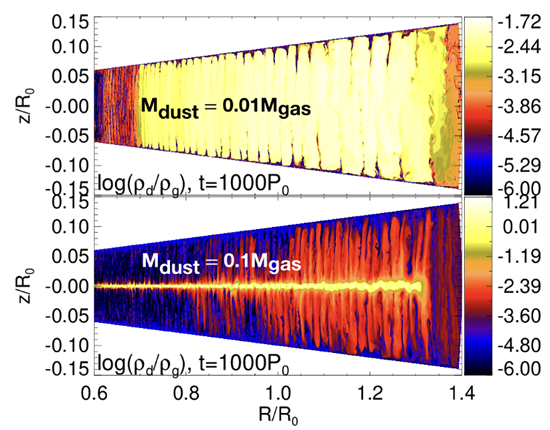研究成果藝廊 > 理論天文物理理論天文物理
(Theory)
研究成果藝廊
理論天文物理理論天文物理
(Theory)
| Dust settling in turbulent protoplanetary disks |
|
圖片來源: Lin (2019)

Numerical simulation of dust settling in turbulent protoplanetary disks. The color scales show the dust-to-gas ratio on a logarithmic scale. The top panel is taken from a simulation with a solid-to-gas mass ratio of 1%, equal to the interstellar medium value. The bottom panel considers a case with an enhanced solid abundance of 10% the gas mass. The thickness of the dust layer decreases with increasing solid abundance. Adapted from Lin (2019).
|
| Planets form in protoplanetary disks (PPDs) surrounding young stars and they appear ubiquitous in the Universe. However, the precise details of planet formation remains a mystery. Understanding the complex solid-gas dynamics within PPDs is necessary towards developing a self-consistent theory of planet formation, including that of our own Earth.
Our current studies focus on how small dust grains and macroscopic protoplanets evolve in PPDs through interacting with the gas via drag and gravitational forces, respectively. These processes are fundamental to the initial formation of planets and their subsequent evolution into observed planetary systems. As a recent example, Lin (2019) simulated the sedimentation of dust particles in PPDs (see the figure), which is widely considered as the first step to planetesimal formation. We show that the overall solid-to-gas mass ratio is an important parameter in determining the degree of settling that can be achieved in turbulent PPDs, which in turn directly controls the efficiency of planetesimal formation. We find that super-solar metallicities are necessary for dust settling. |
 asiaa.sinica.edu.tw 媒體連絡: epo
asiaa.sinica.edu.tw 媒體連絡: epo asiaa.sinica.edu.tw
asiaa.sinica.edu.tw